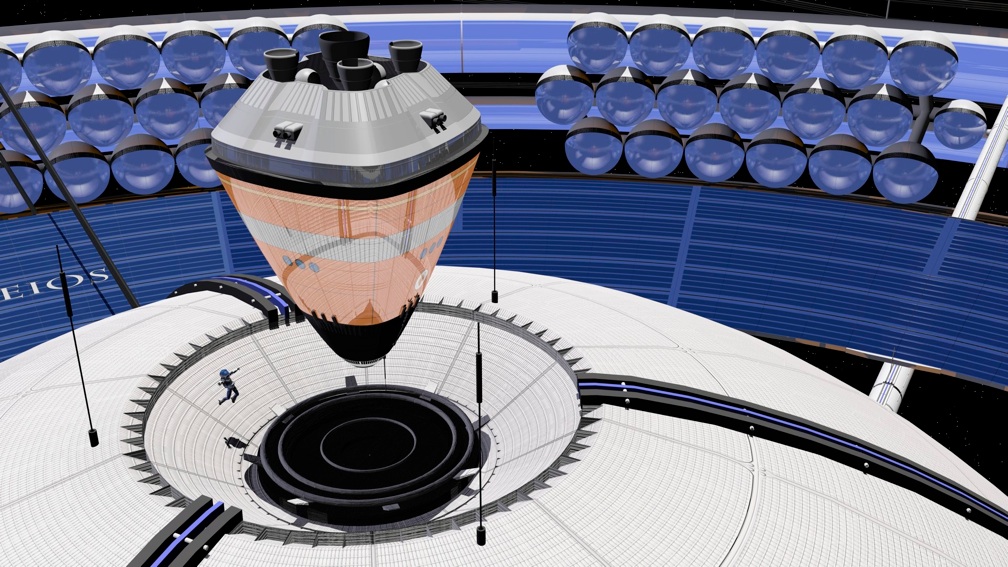Archipel
Prospective of space exploration



Accueil I Prospective I Cartographie I Vaisseaux I Escales I Perspectives I Zooms I Contact I Crédits
© Olivier Boisard - 2006-2013
3 - Other issues
Many other important issues have yet to be explored :
Security
Living in Apogeios is probably less dangerous than living on Earth. Being well protected from cosmic radiation and solar storms, the only external natural risk is the impact of a meteorite. Considering the size of habitat, a "pebble" makes only a negligible leakage, difficult to estimate in the long term. Only a "rock" may cause a rapid depressurization, but the probability of such an event is extremely low.
By cons, the city is facing risks such as fire or explosion, pollution or epidemic. Therefore, it must be designed to prevent any kind of disaster. A first solution is, as for greenhouses, to compartmentalize inhabited areas in order to distribute the risk. And in a crisis situation, the population of an habitat could be temporarily moved in the shelter of the industrial zone, or evacuated thanks to hundreds of inflatable spherical rescue boats.
Mass
On the basis of preliminary calculations and estimations, the following table gives the magnitudes of the masses for the different components of the city.

This means 75 tons per inhabitant. By comparison:
-
• with the ISS : 67 tons / astronaut (6 maximum for a total of 400 tons).
-
• with the famous cruise liner "France": 19 tons / person (for a total of 57000 tons, 300 m long, 34 m width, 12 decks, 2,000 passengers and 1,000 crew members).
-
• with the Montparnasse Tower in Paris : 30 tons / person (209 meters high, 150 000 tons, 59 floors, 1,700 m2, about 5,000 persons).
Transportation
Different kinds of vehicles will ensure the specific needs:
-
•bulks and/or catapults for transporting minerals and raw materials from the Moon and asteroids,
-
•an equipment fleet for surveillance and intervention on the site, and on the Moon and asteroids.
• “liners” for links between the city and Earth, via a relay station on Low Earth Orbit.
Shuttles for freight and passenger can dock on the two stations located at the axis of rotation. From there, it is possible to load / unload cargo containers parked outside. Airlocks can transfer passengers and freight within the industrial area (pressurized) and then be transported to habitats via communication tunnels.
Construction
A long and important preparation must precede the construction of Apogeios. This initial program of "space industrialization" will first produce, locally and in large quantities, aluminum structures, steel cables, concrete protection for GCR, silica and silicon and glass for solar cells, nitrogen, water and oxygen for residents and ecosystems, plastics and oxygen and liquid hydrogen for rocket propulsion.
This basic industry will have to be complemented by the production of many finished products: metal alloys, fluids and various ingredients. But the highly processed products, such as drugs or microprocessors will continue to be manufactured on Earth.
Despite a high degree of automation, mining and processing and especially the construction of the city require the presence of man in situ. Everything won’t be remotely controlled and operated, as the capability for robots to face or foresee critical situation is yet a distant prospect (but can not be excluded).
More than "site huts", "base camps" will be needed. Larger and especially more autonomous than the current orbital stations, they prefigure the city to come. Besides their role during the construction, they will qualify number of essential functions such as artificial gravity, culture in greenhouses, recycling of air and water, ecosystem monitoring and security.
The Growth Potential
On the long term, it will be possible to increase the capacity of the city, but building new cities could be a better solution (before spreading further). The idea of O'Neill was to create an archipelago at the Lagrange Point, for a population of hundreds of thousands or millions inhabitants. Like on Earth, cities would be specialized in different activities, and cultural aspects. Note that long distance transport between these cities would cost nothing in energy or time.
In that way, new additional facilities (for energy, industry, leisure, …) could be build in the neighborhood of Apogeios. For example, a solar power station could transmit the energy produced by a microwaves or laser beam, as for the Earth, and livestock could be introduced in “space farms” without any risk to interfere with the ecosystems of the city.
Conclusion
A as conclusion, we would like to quote these words of Stephen Hawking, in which we recognize our approach:
“I believe that the long-term future of the human race must be in space […]. We have made remarkable progress in the last hundred years. But if we want to continue beyond the next hundred years, our future is in space”.
Références
Are only mentioned here the references used in this text, there are of course many others.
[1]Gerard K. O'Neill, The High Frontier, Space Studies Institute Press, Princeton, New Jersey (1989)
[2]Jean Dunglas, L'Homme et ses écosystèmes dans l'Espace, note de travail (2007)
[3]Donald Rapp, Radiation Effects and Shielding Requirements in Human Missions to the Moon & Mars Comparison of Martian meteorites and Martian Regolith as Shield Materials Galactic Cosmic Rays, Citation: Mars 2, 46-71, (2006)
[4]Dominique Presles - Dominique Paulet, Architecture navale, éditions de la Villette, Paris (2005)
Pierre Marx & Olivier Boisard

© Olivier Boisard & Pierre Marx - 2011
APOGEIOS, a concept of space city
















